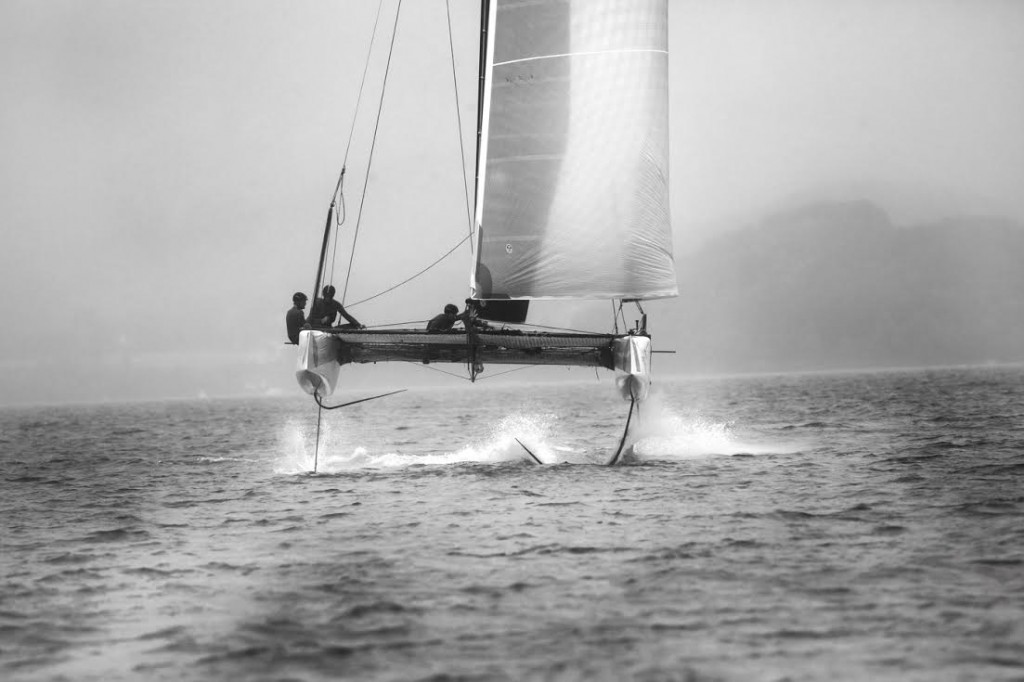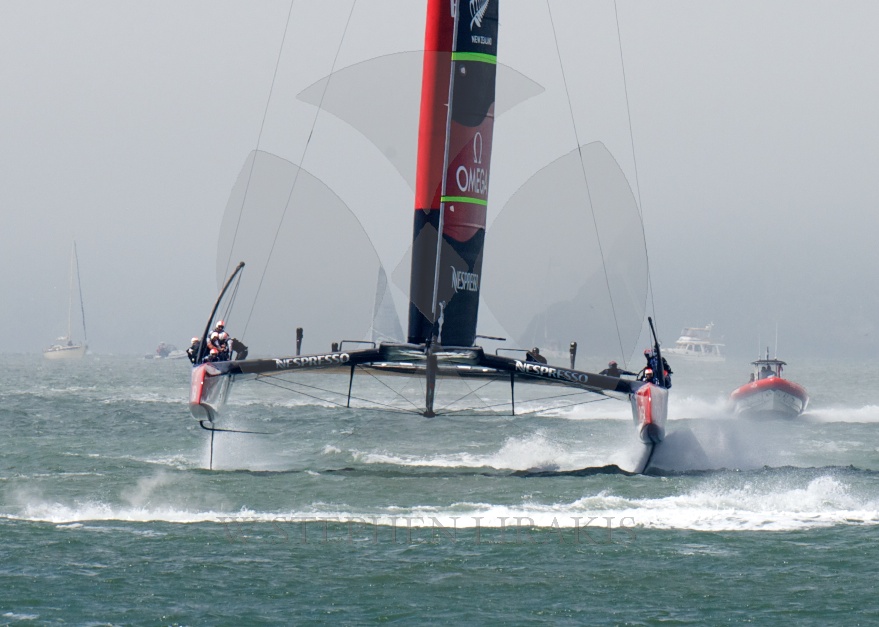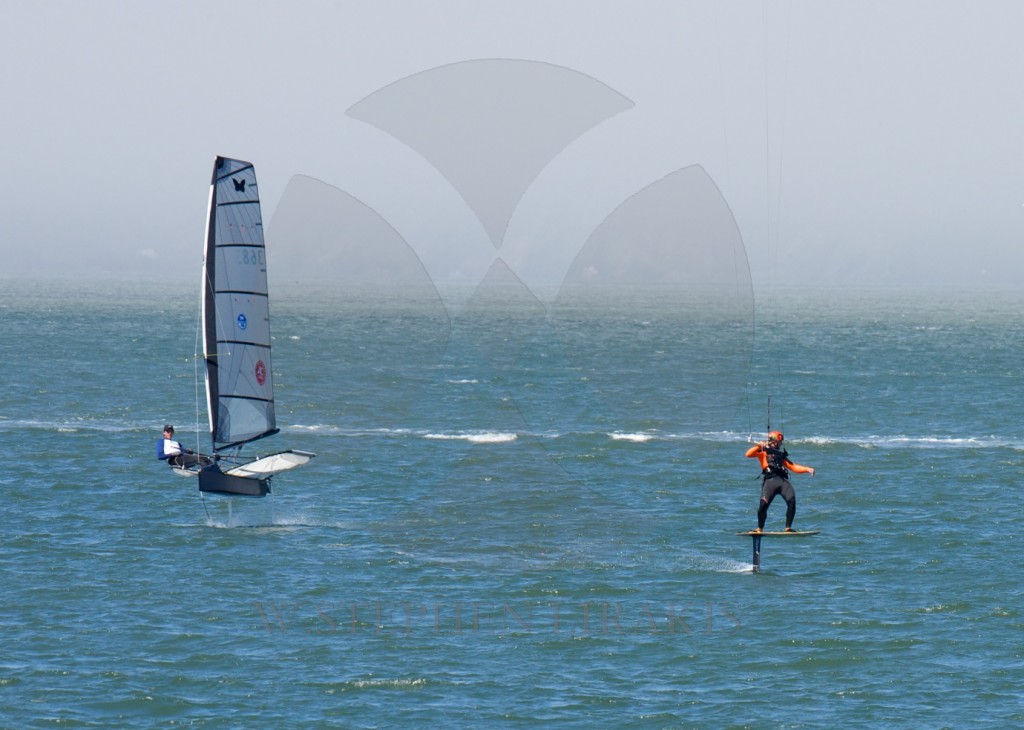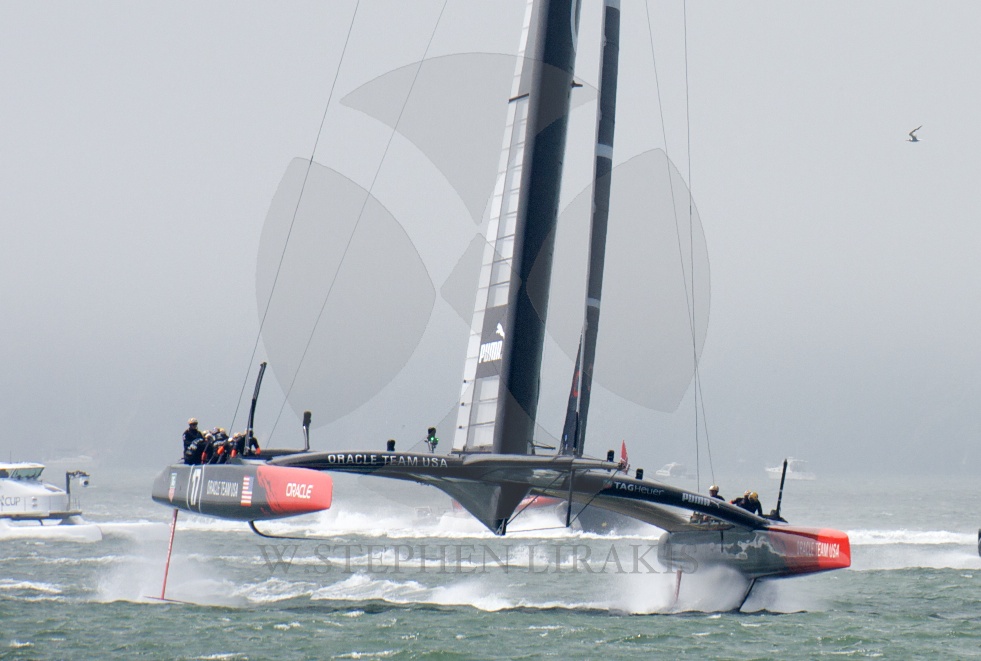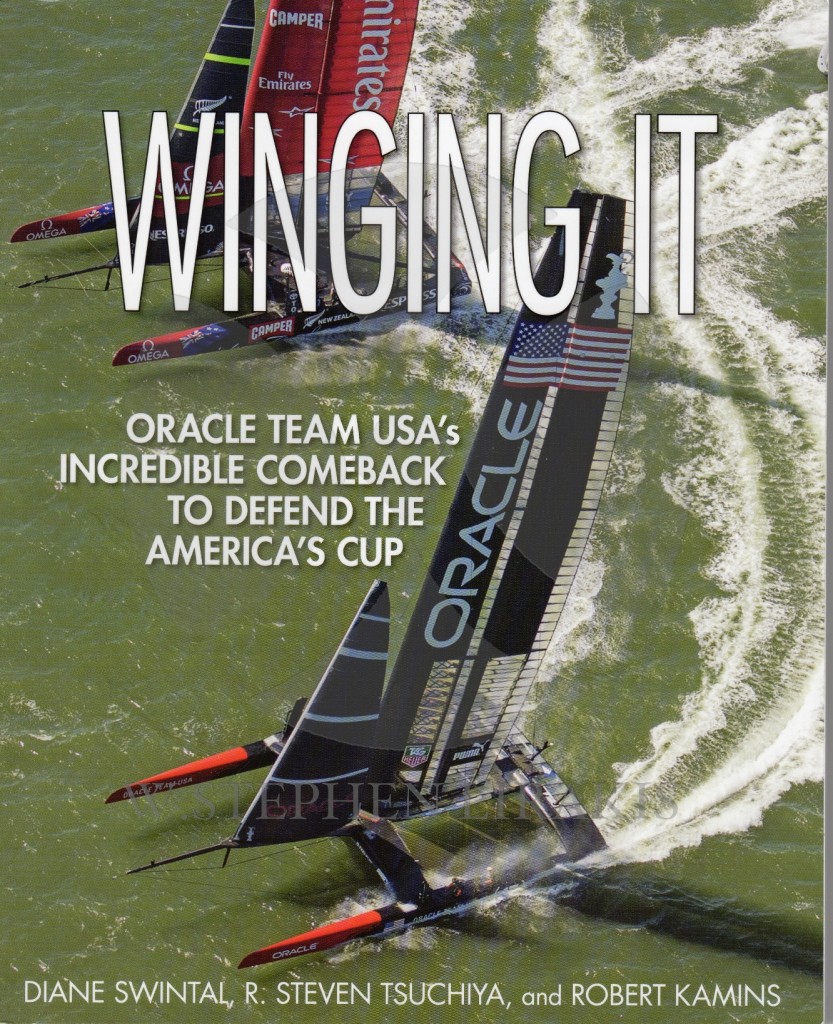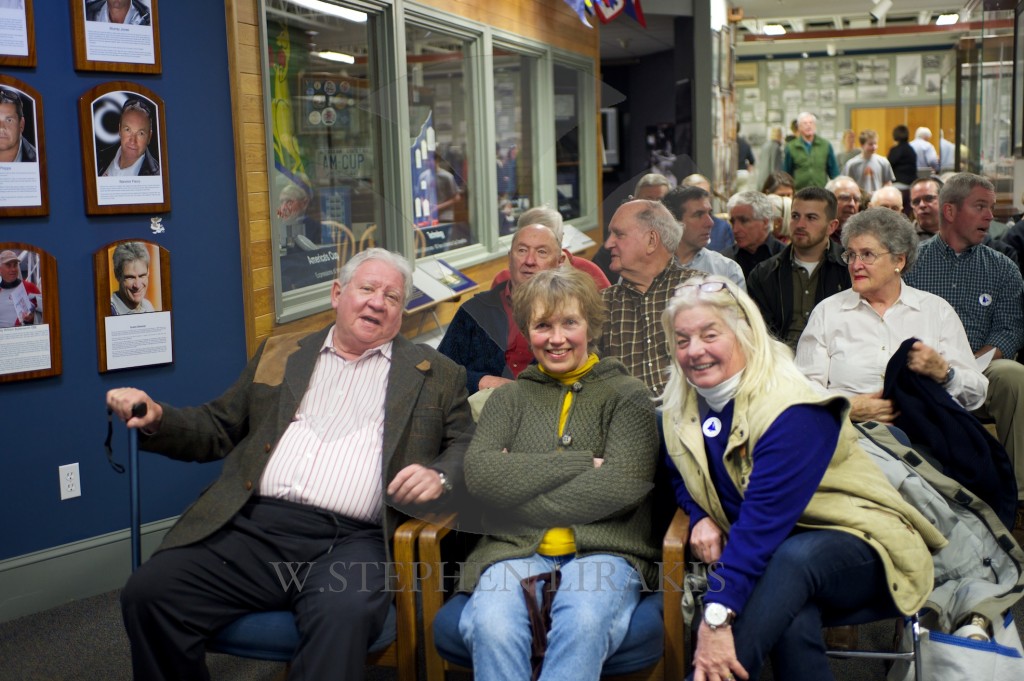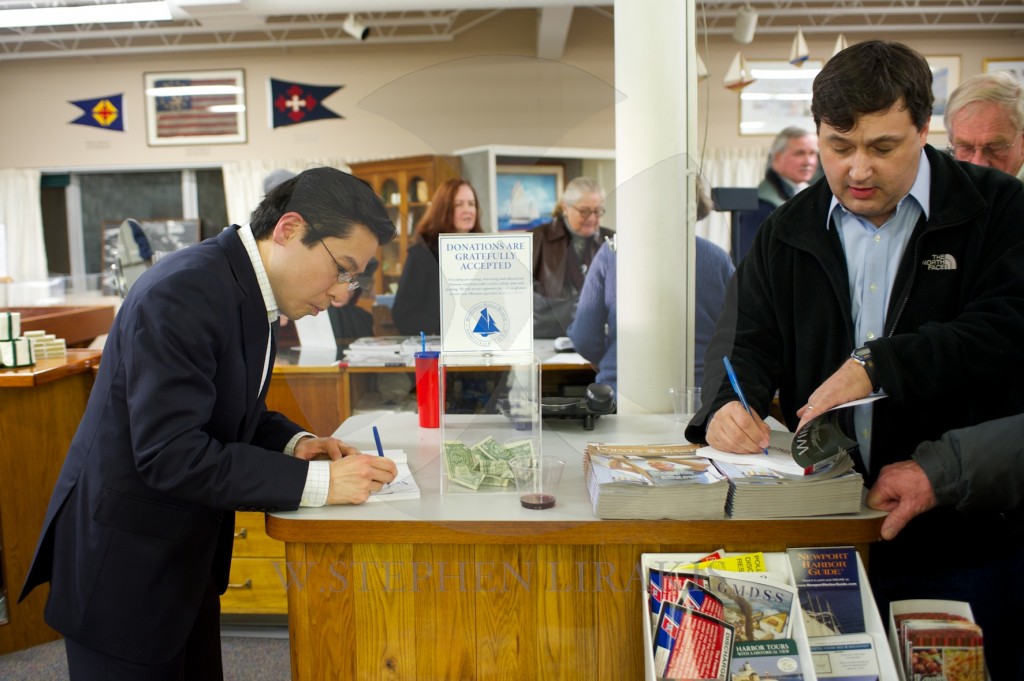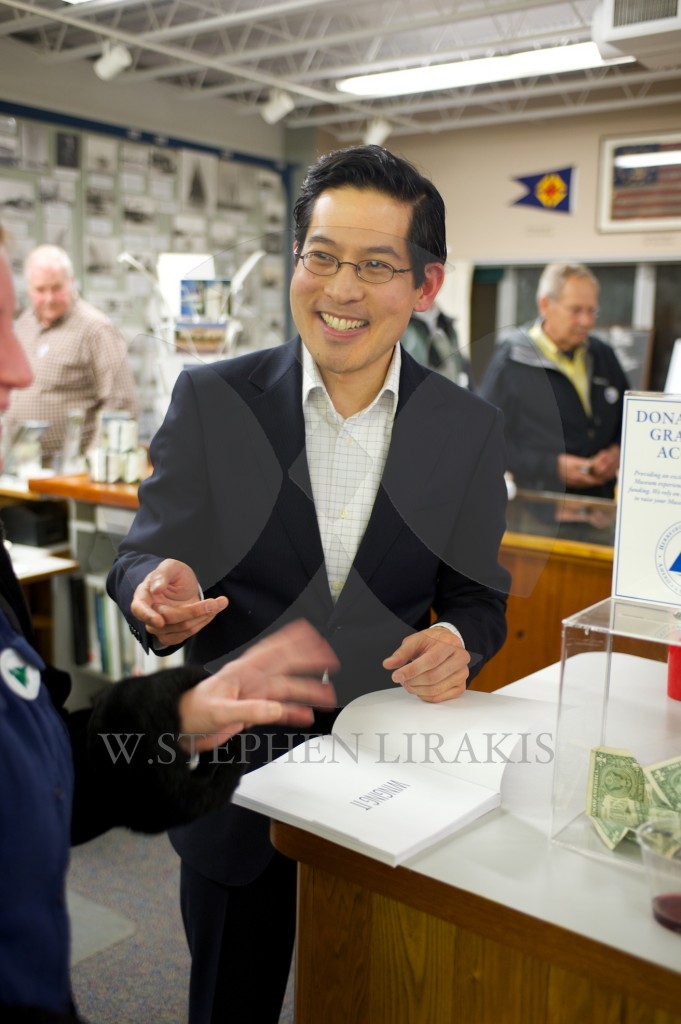America’s Cup- Fast foils-a conversation with Paul Bieker, part I
2:35 PM Sun 2 Mar 2014
 |
| ‘Oracle Design Team – America’s Cup 35. Paul Bieker is in the front row, second from the left’ Amory Ross © |
Few people in the sailing world are sharper than Paul Bieker, a soft-spoken Seattle-based naval architect who has spent his career designing a wide variety of sailing vessels, from super-quick I-14s and his one-off line of ‘Riptide’ racer/cruisers, to America’s Cup yachts.
Bieker is one of the core designers credited with ‘super-charging’ Oracle Team USA’s ‘USA 17’ last September, changes that helped the American-flagged international team to successfully pull-off one of sports history’s greatest comebacks to defend the 34th America’s Cup.
Yet pull up a seat on the rail next to Bieker-as I’ve been fortunate enough to do on many occasions aboard our mutual friend’s Riptide 44-and it quickly becomes obvious that Bieker’s horizons extends far beyond racecourse designs.
Take, for example, the day that he brought our crew lunch. Each sandwich was individually wrapped in brown recycled paper and was hand-tied with a bit of hemp twine in an effort to reduce landfill fodder. Or then there’s Bieker’s insistence that his Riptide designs offer their owners a huge amount of value and utility, irrespective of whether the agenda involves racing, savoring 25-knot kite rides or extended cruising. Bieker is widely regarded as one of the world’s foremost foil-design experts, and while he wisely tries to dodge the limelight, Oracle Team USA has again tapped Bieker for AC35, this time in the role of lead design engineer.
I recently caught up with Bieker at a local Ballard (our mutual Seattle neighborhood) pub for part one of this two-part interview to get his thoughts on how AC34 was won, his design role for AC35, as well as his thoughts on the future of America’s Cup Racing.
Can you tell me about your work with Oracle Team USA, prior to the start of AC34? What were you designing for them?
It was in the late summer/early fall [of 2012] and I think that Oracle had a sense that their appendage engineering and construction side was not going 100-percent smoothly. My first day down there was the day before they launched the boat, and the day they broke their first foil. So pretty much from then on it was full-on, as you can image.
You were mostly working on foils back then?
Yes. They wanted to me to engineer their next-step foil for the boat, but all of a sudden it became ‘shit, we can’t sail the boat-we have no foils’. What actually ended up happening is that I went into producing the first set of raceable foils as quickly as I could, but they still took eight weeks to build. The penny dropped and we realized that we could recycle the structural spars from some surplus daggerboards [from the trimaran, ‘BMW/Oracle 90’, which won AC33]. Those boards had solid carbon spars in them that we could cut out and re-machine into a set of AC72 foils, which we called the ‘nasty boards’.
Those were the modular ones?
They were straight and had brutish-looking boards but the sailors were able to get out sailing with those while we were building the new raceable foils. We didn’t even get the racing boards on the first boat before it tipped over. Then our big job was to do all the repair drawings to repair the hulls and the beams. The boat didn’t go back into the water until after Christmas 2012.
It was a really big repair job?
You have no idea-it was really bad. It was pretty grim. You would have looked at the pile of stuff and said it was close to hopeless. I had a hard time thinking that we could patch all that damage together and not miss something that was going to cause it to fail. The Oracle shore team and boat builders did an amazing job getting the boat back on the water.
How much of the old boat got rebuilt?
We had to cut a good portion of the lower bow off of one hull, and then there were tons of patches everywhere on the central pod and the beams and in the hull. It was painstaking work.
Am I correct that that boat ended up being the faster of Oracle’s two AC72s?
Yes, it was but it was super hard to control downwind. I don’t think we could have raced that boat. It was pretty scary.
Would you say your role as a designer evolved during the course of the campaign?
Well, I was pretty much in charge of daggerboard structures before I got called in to do the repair drawings for the first boat after it tipped over. Then, towards the end of the campaign, I worked on the rudder structures and rudder hydrofoils. During the Cup things got a little [looser] with the general theme of doing whatever you could to figure out how to make the boat go faster. But my focus remained on foils.
Did you sail into that first race knowing for sure that you had the slower boat? Or was that a total surprise?
The funny thing is that we thought that if we had a speed deficit, it was going to be downwind. Most likely our aero package was better than theirs, so we expected to be faster upwind. As it turned out, we were about the same speed downwind and maybe a click lower. We might have had a touch of VMG on them downwind, but we were quite a bit slower upwind and we didn’t have our foiling tacking figured out. We thought we had tacking figured out, but Emirates Team New Zealand (ETNZ) were tacking better and sailing a bit faster upwind than we were. So it was the opposite of what we expected, and it was the same for ETNZ. You try and measure the other team’s speed on the water before the match, but there’s a lot of scatter in that data and it usually does not change your preconceptions.
Were you guys pinging them with lasers or something like that?
[I’m] not sure about lasers but we could pace with them on chase boats. If you watch the Louis Vuitton Cup broadcasts, you can see the speeds and other real-time numbers. They really clicked it up in between the Luis Vuitton Cup and the [Cup].
What was funny is that we couldn’t gybe our boat reliably until probably two or three weeks before the Cup. With a flying gybe, you lose somewhere between 30 and 60 meters per gybe, sometimes less-not much more than a boat length if you do it right. But if you touch down in the water during a gybe, you lose over 150 meters! So it’s going to cost you somewhere between 100 and 120 meters if you touch the water during a gybe and the other team doesn’t, so we were totally fixated on downwind gybing going into the Cup.
We were just really fixated on foiling gybes and probably for good reason because we knew we only had to miss one gybe that they got and the race was probably over, so we concentrated on that in lieu of working a lot on our upwind speed and maneuvers. ETNZ, however, concentrated on upwind [work] because they had their gybing nailed long, long before the Cup. Part of our problem is we had Boat One, which was really unstable downwind-it was just hard to keep her stable on foils. We were generally sailing with rudder wings that were maybe a little bit too small. So Oracle and ETNZ leapfrogged each other, they ended up faster than us upwind and we ended up faster downwind.
Can you describe to me a little bit about what the atmosphere was like after that first week of racing?
It was pretty grim…like really grim.
Was it the sailors, the designers or everybody who was feeling down?
It was pretty much everybody-some [people were] concealed and others not so concealed. The thing is that after you’ve done a couple of Cups, you know that everything goes poof at the end of the campaign. Everything that existed no longer exists. So there you are with this beautiful boat and team at the apex of the sport, right at that moment, but right after the Cup ends, the boat just becomes something that you have to store somewhere and the team disbands. And so you realize that you need to muster up whatever energy you have for that final push, because it really is a sprint to the finish and after the finish it just doesn’t matter anymore. After the finish everything else is gone so you shouldn’t leave anything in the tank. I’d say that probably a third of the people on the team felt like that. Another third were just going through the motions and just doing their job, and another third had already given up. In a traditional America’s Cup, the 8-1 hole is the sort of deficit you’d never be able to come back from. Luckily, the sailing team kept a positive attitude.
 |
|
|
So that sounds like Jimmy Spithill’s bravado about ‘we can win races, it’s not over yet’ was just bluster?
He may have felt that way, I don’t know. He was definitely pretty down in the dumps during a few unguarded moments, but he kept his nose up and then guys on the team stepped up to the plate and made the improvement.
Tell me a little bit about how were politically able to introduce the changes that you made at the end. Was this a matter of convincing the design team, or convincing the sailing team, or at that point was everybody just throwing ideas at the wall?
It’s a little bit of the latter. Basically, when we were down five or six points it was pretty dire. People were starting to bring beers to the design meetings and it got way [looser] than normal. You know, ‘who has got ideas?’, and it seemed like you basically needed one person to agree with you, and you were just going to do it. We just got lucky.
The thing was at the part of the regatta that we were in trouble, we had lay days so we could do things to the boat
and test them and if we didn’t like them, we could take remove them. When ETNZ was in that sort of situation, they didn’t have any lay days.
Basically, what we were doing with the rig during the whole event was trying to put the center of pressure further and further aft. We were flattening the jibs. We were opening up the little tab at the aft end of the first element on the wing to load the flap on the wing. We almost doubled our traveler load on the wing between the beginning of the regatta and the end, so we were really trying to move pressure aft. One of the things we tried to do was rake the rig.
We went out on one of the lay days after we had done a big rig change the night before. This involved different shroud lengths, a recut to the jib, wing base modifications, etc. The guys went out and they didn’t like it so we spent the next night putting everything back for the next race day. If that had not been a lay day, we would have probably lost that race. It really worked for us to have lay days when we were in strife, and for ETNZ not to have that luxury.
You told me once you added a faring to the interceptor ramps so that the sailors wouldn’t freak out on a 90 degree edge. Who has ultimate say on what actually goes on the boat and what doesn’t? Russell Coutts or you?
It would have been Russell [Coutts], Dirk Kramer and Grant Simmer that made the final calls on what went on the boat. When I suggested it Michel Kermarec [N.B., Kermarec was Oracle’s appendage designer and VPP lead for AC34] thought it sounded like a good idea, so that was all it took. The next thing you know, we’re putting this wedge on the stern of the boat so that anyone who walks up is just going ‘huh?’, but what was neat about it is that if you explained it to the guys, they would go along with it, even though it didn’t look right to them. That’s the cool thing about the America’s Cup-the technology drives it and the sailors understand that.
What was the reaction from the sailing and design teams once the interceptor ramps and the Rudder/hydrofoil intersection cavitation fairings started to really show their results?
We were doing a whole lot of different things, so whether the interceptor helped or not, I’m not sure. I’m pretty sure it helped the boat when it was in that skimming mode, going into takeoff, but how much I can’t say. The fairings on the rudders definitely helped. We did calculations that showed that they were 0.6 knots faster downwind in the 40-knot range of boatspeed, but those fairings didn’t make us any faster upwind. What made us faster upwind was changing the wing trim, and the fact that the crewed figured out how to foil tack. By the end of AC34, they were taking better than ETNZ.
What do you think were the biggest factors in Oracle’s come-from-behind win?
My guess is that the biggest things were dialing in the wing trim, crew work and the [foiling tacks]. One of the other big things the guys learned is that very aggressively trimming the wing-I wouldn’t say pumping-is a way to get up on foils without bearing off too much. In our practice foiling upwind, the problem was that you had to bear away so much to get up on the foil that you would just barely make it back to where you were by the time you had to tack and the tacking-before the Cup-was violent. The boat would come through and the old leeward hull/new windward hull would all come down into the water and it was pretty slow.
The trick was that once you figured out how to tack the boat, you aren’t dragging this long skinny hull through the water in the middle of the tack, you’re just up on three foils. This means that you’re losing almost nothing, whereas in a normal multihull you’re taking this big long thing and you’re trying to make it turn through the water. You lose a lot in the beginning of the tack, but when you do a foiling tack you lose almost nothing in the first part of the turn.
The guys learned to carry some lift on the old leeward/new windward foil, and to keep that windward hull up in the air. If you never have two hulls in the water, all of a sudden it paid to be foiling at the beginning of a tack. Before, it was a such a violent maneuver that you lost a lot of speed.
I think I read somewhere that one of the ways the guys learned to improve tacking was by watching videos on how ETNZ was pulling off their foiling tacks?
I’m sure they watched lots of the videos of those guys, and they watched also lots of videos of themselves. We had a pretty neat data-collection system on the boat so you could look at different tacks to determine if you had a good tack or a bad tack. You had video from lots of different angles, so you could really start to identify what made a tack good and what made a tack bad. You could really look at it in detail.
The cool thing wasn’t like we were all, as a big group, analyzing the footage. The crew was working hard on the tacking side of it, and we were working on the design side of it and luckily we went forward in most places.
Where do you physically do a lot of your design work?
Here in Seattle.
So was the Cup won right here in Ballard?
I don’t know if the Cup was won right here in Ballard, but we did a lot of the foil work right here. I like working here just because we’ve got a nice office environment. It’s quiet, and I can concentrate.
Do you have a specific title with Oracle Team USA for AC35 at this point?
I think I’m called the Senior Design Engineer, but I don’t know exactly what that means. I’m in charge of making sure the structure of the boat is right and that the systems are properly integrated, and I’ll be involved in the naval architecture side of it as well.
Can you talk a little bit about the work that you’ve done with the design rule for AC35?
Basically the Challenger of Record and the Defender are trying to reduce the cost of the boats so that smaller teams can get in and run a reasonable campaign with a moderate amount of money. We really want to be able to foil upwind in moderate air. Right now we’re sort of hoping we can foil upwind in 12 knots of wind and foil downwind in eight knots or so.
Stay tuned for part two of this two-part interview, later this week.
by David Schmidt, Sail-World USA Editor


